A simple but effective fly featuring some unusual and interesting tying techniques. Developed by Jack Gartside
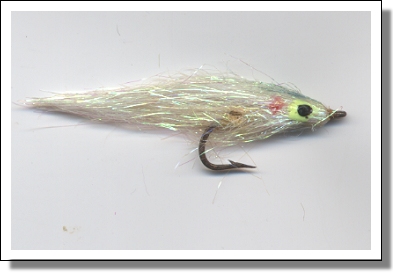
The "Secret" Baby Baitfish is the first in a series of flies that I will present each month or as time allows. This "Fly of the Month" series will feature both salt and fresh water patterns that I have developed over the years, flies that are not only interesting to tie but have proven their effectiveness over time. If you have any requests as to a pattern you would like me to present, please let me know. Happy Tying!
A few words about Gartside's Secret Stuff (or "GSS")
I've been playing around with this extremely soft, hair-like material ever since I was introduced to it about three or four years ago and have been impressed ever since by its unusual qualities and the many uses to which it can be put. I've tied with it, fished with it, and have taught many fly tying classes how to work imaginatively with it. And, I have to honestly say, that it's one of the few synthetic materials I've come to enjoy tying with and fishing. I hope you find it similarly enjoyable.
Gartside's Secret Stuff is much more than a "hair" substitute and the imaginative tyer will find many uses besides the ones to which I've put it. For those who have not used this material before, the most noticeable quality it has is the way in which the material melts and turns into a fast-drying, epoxy-like hardness when head cement (mixed with acetone) is applied to it. Because of this quality you can easily and quickly shape a wide variety of body and head shapes to create a vast array of unusual effects. (A word of warning here: Apply your cement ONLY to the area you want to harden — and don't even think of using only acetone (without admixing it with head cement) — the material will soak it all up and the whole shebang will harden.
The name — Gartside's Secret Stuff — was attached to it a few years ago while giving a fly tying class down in Maryland. We were tying a pattern that I hadn't yet given a name to. I jokingly referred to it as "Gartside's Secret" (which eventually became a sort of generic name that attached itself to any pattern using this material). When someone in the class asked me what the material was called, I replied simply, "Gartside's Secret Stuff." And the name stuck. When the students asked me where to get this stuff, I couldn't tell them — there was nothing like it on the market at the time — and so I decided to buy a moderate amount of it for my classes and to sell the stuff directly to the students. After a while, I bought more stuff and put it into packages to offer it to the general fly tying public.
Since that time, other hairs similar to this stuff have appeared on the market and while they may look similar to Gartside's Secret Stuff, they are usually quite different and are used primarily and simply as "hair." GSS is 100% polyester and is drawn down to the finest denier possible so that it is as soft a material as soft can be and can be used for a wide variety of purposes. In a pinch, other materials may be substituted for GSS — e.g., GoofusHair or AngelHair (both similar but not the same) but the results won't be the same; besides that, the aforementioned materials tend to be very expensive. For the frugal (and the patient) you can even do what I did originally, back in the 70's: cut up an old disco shirt (polyester or rayon) and comb out the fibers with a wire brush (these threads tend to be quite a bit thicker than GSS but you might be intrigued with the results). Remember: the secret in Secret Stuff is not in the material but in the unusual methods I've developed for using this stuff imaginatively. And I'm happy to share with you one of my secrets.
For more secrets, see my book: "Secret Flies" featuring numerous unusual tying techniques and patterns that can be tied using GSS.
Tying the Secret Baby Baitfish
|
Hook: |
Mustad 34007(SW), M3406 (FW) or equivalent |
|
Thread: |
3/0 monocord |
|
Body: |
Dubbed and picked out strands of Pearl GSS |
|
Cement: |
Any head cement that can be thinned with acetone |
|
Notes: |
Handy tools for working with this unusual material include a bodkin and a brush/comb called an "eyelash groomer" (found in any cosmetics store), as well as a wooden match for painting on the eyes. Head cement may be any that can be thinned with acetone (approximately 10% of the mixture should be acetone). |
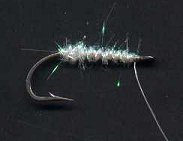 Lay down a base of tying thread along the shank and move thread forward to eye of hook. Dub a small quantity of GSS onto the thread and wind it over the shank to the rear and then forward again to a point just behind the eye.
Lay down a base of tying thread along the shank and move thread forward to eye of hook. Dub a small quantity of GSS onto the thread and wind it over the shank to the rear and then forward again to a point just behind the eye.
Note: for ease of dubbing,break (with your fingers) some of the longer strands of GSS into shorter strands, so that you have mixed lengths.
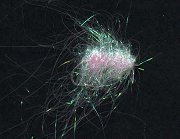 At this point dub a much larger quantity of GSS onto your thread and wind towards the rear of the shank, stopping at the bend of the hook, then winding forward (over previously wound-on dubbing) to just behind the eye. (Make your body as thick or as thin as you wish — but it should always be thicker towards the head area — to imitate the baitfish of your choice.
At this point dub a much larger quantity of GSS onto your thread and wind towards the rear of the shank, stopping at the bend of the hook, then winding forward (over previously wound-on dubbing) to just behind the eye. (Make your body as thick or as thin as you wish — but it should always be thicker towards the head area — to imitate the baitfish of your choice.
A hint: Don't dub GSS onto thread too tightly and don't use a dubbing loop — you want to eventually pick out loose strands (it's the successive turns of thread and windings of material over itself which will bind it securely to the hook shank). Whip finish small thread head in back of eye and tie off.
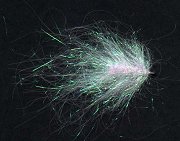 With a bodkin, pick out from all sides of the body as many strands as you need to give body and movement to your imitation. To create a fuller interior body, "rake" body material close to and along the shank, to loosen up the shorter strands.
With a bodkin, pick out from all sides of the body as many strands as you need to give body and movement to your imitation. To create a fuller interior body, "rake" body material close to and along the shank, to loosen up the shorter strands.
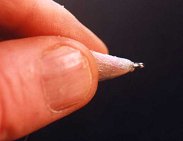 Determine the desired shape and length of the head. With your thumb and forefinger sweep strands near the eye to the rear and hold in place at rear of head area. Add a couple of drops of thinned head cement to all sides of this head area-but ONLY to the area you want to harden. Hold strands in place for about eight seconds until melting is complete and cement begins to harden. While the head area is still malleable, shape your head to desired shape and smooth out any unevenness with your bodkin or fingers.
Determine the desired shape and length of the head. With your thumb and forefinger sweep strands near the eye to the rear and hold in place at rear of head area. Add a couple of drops of thinned head cement to all sides of this head area-but ONLY to the area you want to harden. Hold strands in place for about eight seconds until melting is complete and cement begins to harden. While the head area is still malleable, shape your head to desired shape and smooth out any unevenness with your bodkin or fingers.
Helpful hint: When smoothing out your head and shaping it, daub a little "nose oil" or Vaseline on you fingers, to keep them from sticking to the material.
With your fingers, trim your finished fly to desired length and shape by breaking away unwanted strands. Add eyes when cement is dry and with a waterproof art marker color the baitfish to desired color. For an extra hard head (and to further secure the eyes), add another coat of head cement to head area.






